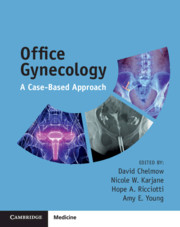Book contents
- Office Gynecology
- Office Gynecology
- Copyright page
- Contents
- Contributors
- Preface
- Section I Pelvic Pain
- Section II Vaginal Discharge and Sexually Transmitted Infections
- Section III Amenorrhea and Abnormal Vaginal Bleeding
- Section IV Contraception and Abortion
- Section V Breast Problems
- Section VI Cancer Screening and Prevention
- Section VII Vulvar Disease
- Section VIII Infertility
- Section IX Preconception Planning
- Section X Pediatric and Adolescent Problems
- Section XI Pelvic Masses and Cysts
- Section XII Incontinence and Prolapse
- Section XIII Behavioral, Sexual, and Social Health
- Section XIV Managing and Aging
- Index
- References
Section VI - Cancer Screening and Prevention
Published online by Cambridge University Press: 20 February 2019
- Office Gynecology
- Office Gynecology
- Copyright page
- Contents
- Contributors
- Preface
- Section I Pelvic Pain
- Section II Vaginal Discharge and Sexually Transmitted Infections
- Section III Amenorrhea and Abnormal Vaginal Bleeding
- Section IV Contraception and Abortion
- Section V Breast Problems
- Section VI Cancer Screening and Prevention
- Section VII Vulvar Disease
- Section VIII Infertility
- Section IX Preconception Planning
- Section X Pediatric and Adolescent Problems
- Section XI Pelvic Masses and Cysts
- Section XII Incontinence and Prolapse
- Section XIII Behavioral, Sexual, and Social Health
- Section XIV Managing and Aging
- Index
- References
- Type
- Chapter
- Information
- Office GynecologyA Case-Based Approach, pp. 114 - 137Publisher: Cambridge University PressPrint publication year: 2019



